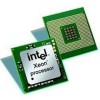Intel X5472 Specification Update - Page 36
Enabling PECI via the PECI_CTL MSR Does Not Enable PECI and May
 |
UPC - 735858201551
View all Intel X5472 manuals
Add to My Manuals
Save this manual to your list of manuals |
Page 36 highlights
of the VMM may not be invalidated. In addition, if a guest is using global page entries, then on a VM exit, the instruction TLB entries caching global page translations of the guest may not be invalidated. Implication: Stale global instruction linear to physical page translations may be used by a VMM after a VM exit or a guest after a VM entry. Workaround: It is possible for the BIOS to contain a workaround for this erratum. Status: For the steppings affected, see the Summary Tables of Changes. AX63. Problem: XRSTOR Instruction May Cause Extra Memory Reads An XRSTOR instruction will cause non-speculative accesses to XSAVE memory area locations containing the FCW/FSW and FOP/FTW Floating Point registers even though the 64-bit restore mask specified in the EDX:EAX register pair does not indicate to restore the x87 FPU state. Implication: Page faults, data breakpoint triggers, etc. may occur due to the unexpected nonspeculative accesses to these memory locations. Workaround: It is possible for the BIOS to contain a workaround for this erratum. Status: For the steppings affected, see the Summary Tables of Changes. AX64. Enabling PECI via the PECI_CTL MSR Does Not Enable PECI and May Corrupt the CPUID Feature Flags Problem: Writing PECI_CTL MSR (Platform Environment Control Interface Control Register) will not update the PECI_CTL MSR (5A0H), instead it may corrupt the CPUID feature flags. Implication: Due to this erratum, PECI (Platform Environment Control Interface) will not be enabled as expected by the software. In addition, due to this erratum, processor features reported in ECX following execution of leaf 1 of CPUID (EAX=1) may be masked. Software utilizing CPUID leaf 1 to verify processor capabilities may not work as intended. Workaround: It is possible for the BIOS to contain a workaround for this erratum. Status: For the steppings affected, see the Summary Tables of Changes. AX65. Corruption of CS Segment Register During RSM While Transitioning From Real Mode to Protected Mode Problem: During the transition from real mode to protected mode, if an SMI (System Management Interrupt) occurs between the MOV to CR0 that sets PE (Protection Enable, bit 0) and the first far JMP, the subsequent RSM (Resume from System Management Mode) may cause the lower two bits of CS segment register to be corrupted. Implication: The corruption of the bottom two bits of the CS segment register will have no impact unless software explicitly examines the CS segment register between enabling protected mode and the first far JMP. Intel® 64 and IA-32 Architectures Software Developer's Manual Volume 3A: System Programming Guide, Part 1, in the section titled "Switching to Protected Mode" recommends the far JMP immediately follows the write to CR0 to enable protected mode. Intel has not observed this erratum with any commercially available software. Workaround: None Identified Status: For the steppings affected, see the Summary Tables of Changes. Intel® Xeon® Processor 5400 Series 36 Specification Update















